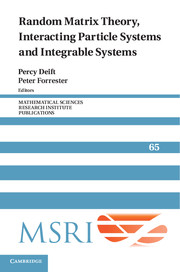Book contents
- Frontmatter
- Contents
- Preface
- Universality conjecture for all Airy, sine and Bessel kernels in the complex plane
- On a relationship between high rank cases and rank one cases of Hermitian random matrix models with external
- Riemann–Hilbert approach to the six-vertex model
- CLT for spectra of submatrices of Wigner random matrices, II: Stochastic evolution
- Critical asymptotic behavior for the Korteweg–de Vries equation and in random matrix theory
- On the asymptotics of a Toeplitz determinant with singularities
- Asymptotic analysis of the two-matrix model with a quartic potential
- Conservation laws of random matrix theory
- Asymptotics of spacing distributions 50 years later
- Applications of random matrix theory for sensor array imaging with measurement noise
- Convolution symmetries of integrable hierarchies, matrix models and τ-functions
- Universality limits via “old style” analysis
- Fluctuations and large deviations of some perturbed random matrices
- Three lectures on free probability
- Whittaker functions and relatedstochastic processes
- How long does it take to compute the eigenvalues of a random symmetric matrix?
- Exact solutions of the Kardar–Parisi–Zhang equation and weak universality for directed random polymers
- Replica analysis of the one-dimensional KPZ equation
- Asymptotic expansions for β matrix models and their applications to the universality conjecture
- KPZ scaling theory and the semidiscrete directed polymer model
- Experimental Realization Of Tracy–Widom Distributions And Beyond: Kpz Interfaces In Turbulent Liquid Crystal
- Random matrices: the four-moment theorem for Wigner ensembles
Replica analysis of the one-dimensional KPZ equation
Published online by Cambridge University Press: 29 May 2025
- Frontmatter
- Contents
- Preface
- Universality conjecture for all Airy, sine and Bessel kernels in the complex plane
- On a relationship between high rank cases and rank one cases of Hermitian random matrix models with external
- Riemann–Hilbert approach to the six-vertex model
- CLT for spectra of submatrices of Wigner random matrices, II: Stochastic evolution
- Critical asymptotic behavior for the Korteweg–de Vries equation and in random matrix theory
- On the asymptotics of a Toeplitz determinant with singularities
- Asymptotic analysis of the two-matrix model with a quartic potential
- Conservation laws of random matrix theory
- Asymptotics of spacing distributions 50 years later
- Applications of random matrix theory for sensor array imaging with measurement noise
- Convolution symmetries of integrable hierarchies, matrix models and τ-functions
- Universality limits via “old style” analysis
- Fluctuations and large deviations of some perturbed random matrices
- Three lectures on free probability
- Whittaker functions and relatedstochastic processes
- How long does it take to compute the eigenvalues of a random symmetric matrix?
- Exact solutions of the Kardar–Parisi–Zhang equation and weak universality for directed random polymers
- Replica analysis of the one-dimensional KPZ equation
- Asymptotic expansions for β matrix models and their applications to the universality conjecture
- KPZ scaling theory and the semidiscrete directed polymer model
- Experimental Realization Of Tracy–Widom Distributions And Beyond: Kpz Interfaces In Turbulent Liquid Crystal
- Random matrices: the four-moment theorem for Wigner ensembles
Summary
In the last few years several exact solutions have been obtained for the onedimensional KPZ equation, which describes the dynamics of growing interfaces. In particular the computations based on replica method have allowed to study fine fluctuation properties of the interface for various initial conditions including the narrow wedge, flat and stationary cases. In addition, an interesting aspect of the replica analysis of the KPZ equation is that the calculations are not only exact but also “almost rigorous”. In this article we give a short review of this development.
1. Introduction
The one-dimensional Kardar–Parisi–Zhang (KPZ) equation,
is a well known prototypical equation which describes a growing interface [Kardar et al. 1986; Barabási and Stanley 1995]. Here h(x, t) represents the height of the surface at position x ∈ ℝ and time t ≥ 0. The first term represents a non linearity effect and the second term describes a smoothing mechanism. The parameters λ and υ measure the strengths of these effects. The last term η(x, t) indicates the existence of randomness in our description of surface growth. For the standard KPZ equation it is taken to be the Gaussian white noise with covariance,
Here and in the remainder of the article, (...) indicates an average with respect to the randomness η.
The KPZ equation (1) is a nonlinear stochastic partial differential equation (SPDE), which is difficult to handle in general. But fortunately the KPZ equation has a nice integrable structure which has allowed detailed studies of its properties. In particular the one-point height distribution has been computed explicitly for three different initial conditions: the narrow wedge h(x,0) = -|x|/δ,δ→0
[Sasamoto and Spohn 2010a; Amir et al. 2011], the flath(x,0)=0,x∈ ℝ [Calabrese and Le Doussal 2011], and the stationary, h(x, 0) = B(x) [Imamura and Sasamoto 2012], cases. Here B(x),x∈ ℝ represents the (two-sided) onedimensional Brownian motion with B(0)= 0. From the narrow wedge initial condition the surface grows to a shape of parabola macroscopically, which is representative of a curved surface. The flat case has been the most typical initial condition for Monte Carlo simulation studies, whereas the stationary case is regarded as one of the most important situation from the point of view of nonequilibrium statistical mechanics
Information
- Type
- Chapter
- Information
- Publisher: Cambridge University PressPrint publication year: 2014
